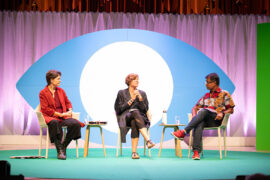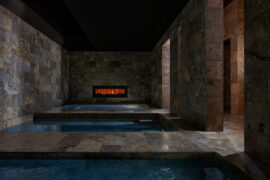With the New Year well and truly upon us, we’ve put together the top 5 ways we want to see design thinking evolve in the coming 12 months.

January 22nd, 2018
Last year was a big one for Australian design. From cleaning up at various international awards to the launch of countless new and exciting products and fresh talent, the industry has spent the past 12 months going from strength to strength. More than ever, Australia has cemented itself as a major player on the global design stage, and one that is driven by a bold and inimitable way of design thinking.
Still, we’re sure that there remain untold depths to what Australian design has to offer, and know that 2018 will provide us with a tantalising glimpse into these depths. Australian design cannot continue on its astounding trajectory if the design thinking driving it stagnates or slows. Below, we set out five key ways that we want to see Australian design thinking evolve in the coming year.
As we’ve previously reported, minimalism is making a comeback. Thanks to the advent of conscious consumerism and the growing popularity of a restrained, pared-back aesthetic, the allure of simple, streamlined, and straightforward products are perhaps stronger than ever. Design thinking should embrace this shift, taking a leaf out of Mies’ book and revisiting the idea that “less is more”.
Yet what does “less is more” really mean in 2018? An increasingly discerning market means that consumers are no longer satisfied simply by less: essentially, they are interested in less complication and more of everything else. According to a recent study, around 50% of office workers are completely baffled by the many adjustability controls on task chairs, and either toggle them hoping for the best or ignore them completely. Similarly, last year the New York Times reported that the iPhone’s mounting features were confusing many users, who were overwhelmed by the number and diversity of available apps and functions.
Moral of the story for designers? Keep it simple, curate your ideas, and stick to the core of what makes your product great. Identify a clear goal and let this guide you at all stages of design thinking. Above all, remember that your product doesn’t need to do everything: being exceptional at a few things is far better than being okay at many.
Again, we believe that today’s design thinking has a lot to gain from the past, especially the famous “learn by doing” ethos of Ray and Charles Eames. This year, we want to see designers and researchers work more closely together to ensure that designers have a comprehensive understanding of their intended users’ wants and needs from the outset. We’re encouraging a shift in design thinking toward an understanding of design as a tool for shaping the experience but not dictating it – as a means of allowing people to do things better but not necessarily differently.
Designers should continually nourish their skills of empathy for their users and invest more into finding out how people do things, how they like to do them, and what needs further improvement. The best way to figure these things out is through doing – by talking to potential users and iteratively testing products to work out their strengths and limitations. This is a significant undertaking and investment of time and resources, but the burden is tempered by a simple shift in design thinking: if rigorous, earnest testing is reconceived of as a necessary precursor to designing a valuable, actually useful product, it won’t feel like a hurdle so much as a help.
In the age of Instagram, Pinterest, and other forms of social media, it’s easy to be driven by what will get the most likes, drive the most traffic, and win the largest possible amount of social capital. But this year, we’d like to see design thinking shift away from a season-driven approach and toward one that instead celebrates good design that holds its value year-round, regardless of where it falls on the trend cycle.
Design thinking this year should encourage individuality over following the crowd, champion the thrill of piecing together an interesting aesthetic bit by bit over mindlessly recreating the saved image, and shape design that is made to work and look good well into the future, and not just for the minute. This shift in design thinking should also extend to consumers and the way that they themselves think about design.
Rather than viewing design as a luxury and another cost-inflating dot point on a list of product features, consumers should be primed to think of design as an assurance of performance and quality. In the next 12 months, we’d like to see designers encourage consumers to see good design as a long-term investment and not simply a means of fitting in with the latest and greatest trend to enter the market.
Let’s make this year the year of positivity. As it stands, there is plenty of scope for optimistic design thinking in the current market, in which innovation prevails and consumers are more willing than ever to invest in the Next Big Thing. Instead of viewing new requirements like sustainability or accessibility features as impediments to creativity, design should see these as unique, exciting opportunities to innovate.
Positive design thinking recasts constraints as pathways to developing new, interesting ways in which design can shape users’ lives for the better. In 2018, the playing field for designers has changed. Thanks to changing user attitudes, hobbies, and the unrelenting progress of technology, we’re no longer just working to devise new design-related answers to problems: the problems themselves are changing. If this isn’t something to get excited about, we’re not sure what is.
There’s nothing great about being “average”. To be average is to sit atop the fence, being neither good nor bad nor distinct in any way from the norm. By its very nature, the average is the aggregate of many disparate elements, all smoothed over to remove difference. Diversity has become a significant part of many of our leading creative disciplines, so why should design be any different?
It’s time for a major shift in design thinking. This year, we’re calling for designers to abandon the idea of the “average” user and work toward a new “design empathy” that recognises the many and diverse needs, wants, and abilities of different users. Inclusive design thinking and methodology eschews a one-size-fits-all approach in favour of flexible, adaptable products that address the needs of a wide spectrum of stakeholders. The result? More useful, engaging products and more satisfied, happier users. What’s not to love?
Up next: Why design needs a narrative – a look at the power of storytelling in design.
INDESIGN is on instagram
Follow @indesignlive
A searchable and comprehensive guide for specifying leading products and their suppliers
Keep up to date with the latest and greatest from our industry BFF's!

London-based design duo Raw Edges have joined forces with Established & Sons and Tongue & Groove to introduce Wall to Wall – a hand-stained, “living collection” that transforms parquet flooring into a canvas of colour, pattern, and possibility.

A longstanding partnership turns a historic city into a hub for emerging talent

For Aidan Mawhinney, the secret ingredient to Living Edge’s success “comes down to people, product and place.” As the brand celebrates a significant 25-year milestone, it’s that commitment to authentic, sustainable design – and the people behind it all – that continues to anchor its legacy.

At the World Design Congress in London, a simple idea threaded through two dense days: design is not an island. It moves inside wider systems of economics, policy, finance and ecology.

Set amidst Tokyo’s cyberpunk skyline, this hotel and restaurant nevertheless bring significant Scandivanian softness to the scene.
The internet never sleeps! Here's the stuff you might have missed

Hogg & Lamb’s Albion Bathhouse has been awarded The Health & Wellbeing Space at the INDE.Awards 2025. The project reimagines the contemporary bathhouse as an immersive architectural journey – one that restores balance through atmosphere, materiality and mindful design.

Continually making its presence felt on the architecture and design scene, DKO has seen a plethora of promotions across its studios in mid-year.

Annabelle Smith has been named winner of The Graduate at the INDE.Awards 2025, in partnership with Colorbond. Her visionary project reimagines housing in Aotearoa, proposing a modular and culturally responsive model uniting people, architecture and nature.